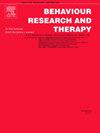Direct and indirect effects of a digital Five Ways to Wellbeing intervention: A network intervention analysis
IF 4.5
2区 心理学
Q1 PSYCHOLOGY, CLINICAL
引用次数: 0
Abstract
While digital positive psychology interventions demonstrate effectiveness in promoting wellbeing and reducing illbeing in the general population, their pathways of change are relatively underexplored. The wellbeing promotive digital intervention, Five Ways to Wellbeing for All (5waysA), has been shown effective (Cohens’ d effect sizes from .20 to .49) in a large (N = 963) randomized controlled trial (Prydz et al., 2024). In the present study, network intervention analysis (NIA) was applied to identify putative direct and indirect effects linking the 5waysA intervention to a set of wellbeing outcomes. Following the 10-week intervention period, the NIA revealed that only positive emotions on an aggregate level were conditionally dependent on the treatment allocation variable. These findings suggest that the effectiveness of the 5waysA intervention primarily reflects the direct enhancement of positive emotions. Our findings provide insights of potential importance for advancing the theoretical framework of the Five Ways to Wellbeing and other mental health and wellbeing promoting interventions.
数字化五种幸福感干预方式的直接和间接影响:网络干预分析
虽然数字积极心理学干预在促进普通人群的福祉和减少疾病方面表现出有效性,但它们的变化途径却相对缺乏探索。在一项大型(N = 963)随机对照试验(Prydz et al., 2024)中,幸福感促进数字干预,五种全民幸福方式(5waysA)已被证明是有效的(科恩效应值从0.20到0.49)。在本研究中,应用网络干预分析(NIA)来确定将5waysA干预与一系列健康结果联系起来的假定的直接和间接影响。在10周的干预期之后,NIA显示只有总体水平上的积极情绪有条件地依赖于治疗分配变量。这些发现表明,5waysA干预的有效性主要反映了积极情绪的直接增强。我们的研究结果为推进五种幸福方式和其他心理健康和幸福促进干预措施的理论框架提供了潜在重要性的见解。
本文章由计算机程序翻译,如有差异,请以英文原文为准。
求助全文
约1分钟内获得全文
求助全文
来源期刊

Behaviour Research and Therapy
PSYCHOLOGY, CLINICAL-
CiteScore
7.50
自引率
7.30%
发文量
148
期刊介绍:
The major focus of Behaviour Research and Therapy is an experimental psychopathology approach to understanding emotional and behavioral disorders and their prevention and treatment, using cognitive, behavioral, and psychophysiological (including neural) methods and models. This includes laboratory-based experimental studies with healthy, at risk and subclinical individuals that inform clinical application as well as studies with clinically severe samples. The following types of submissions are encouraged: theoretical reviews of mechanisms that contribute to psychopathology and that offer new treatment targets; tests of novel, mechanistically focused psychological interventions, especially ones that include theory-driven or experimentally-derived predictors, moderators and mediators; and innovations in dissemination and implementation of evidence-based practices into clinical practice in psychology and associated fields, especially those that target underlying mechanisms or focus on novel approaches to treatment delivery. In addition to traditional psychological disorders, the scope of the journal includes behavioural medicine (e.g., chronic pain). The journal will not consider manuscripts dealing primarily with measurement, psychometric analyses, and personality assessment.
 求助内容:
求助内容: 应助结果提醒方式:
应助结果提醒方式:


